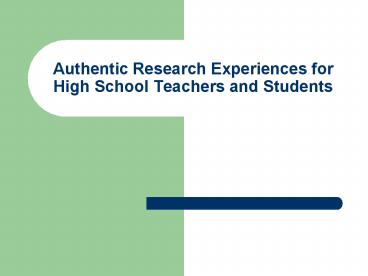Authentic Research Experiences for High School Teachers and Students - PowerPoint PPT Presentation
1 / 16
Title:
Authentic Research Experiences for High School Teachers and Students
Description:
Promote close professional collaboration between ... Stipends, paid travel, cash prizes. What they do during the project. 3 weeks in the field ... It's cheap ... – PowerPoint PPT presentation
Number of Views:71
Avg rating:3.0/5.0
Title: Authentic Research Experiences for High School Teachers and Students
1
Authentic Research Experiences for High School
Teachers and Students
2
Goals of the project
- Increase teachers understanding of authentic
scientific research - How it is conducted, how data are collected, how
questions are phrased, etc. - Improve teachers content knowledge
- Promote close professional collaboration between
high school students and research scientists - Help teachers better incorporate researchboth
content and methodologyinto the classroom
3
The forum
- N-STEP is/was an intensive in-service teacher
research experience requiring collaboration with
high school students and research scientists - Designed for teacher education improvementbenefit
s for students considered a bonus - Part of bigger education reform project (NRC 1996
and AAAS 1989, 1998)
4
How it was designed
- Designed to mimic how scientific research is
conducted - Teams compete for a limited number of openings
- Similar to grant proposal process
- Research products were subject to review by
peers - Via peer review panel
- Incentives were provided to promote excellence
- Stipends, paid travel, cash prizes
5
What they do during the project
- 3 weeks in the field
- Embedded within the context of a 9 month program
with formal class to provide the foundation - Each team is 2 teachers and 2 students and a
lead scientist (PI) - Roughly 5 teams in 2 or 3 different projects
6
The end of the project
- Each student/teacher team
- Writes a research paper
- Prepares a poster
- Gives a 20 minute talk
- All work completed under the guidance of the
leader (PI)
7
The numbersteachers
- 8 projects completed in 3 years
- 50 teachers (some teachers were repeats year to
year) - Gender ratio 5050
- Mostly science teachers
- 90 white
- 94 at high school level
- 96 public school sector
8
The numbersstudents
- 74 students
- All high school students
- Gender ratio 6238
- 81 white
- 7 African-American
- 5 Hispanic
- 4 Asian/Pacific Islander
- 3 Native American
- 78 from urban areas
9
Types of Projects completed
- Anasazi pottery
- Evaporation data from Lake Tahoe
- Ozone column amounts
- Meteorological observations
- Ultraviolet flux measurements
- Soil permeability in Death Valley
- Vegetation composition and density
10
How was the data?
- Varies from group to group
- Some collected excellent data while some data had
to be tossedoverall, scientists were satisfied
with the data - Comments from teachers
- Too much time on irrelevant information about
evaporation (for example) and not enough about
how to use the equipment - This got better by year 2 and 3scientists learn
from the feedback
11
Favorite quote
- Certainly collection of reliable data was not as
efficient as using well-trained graduate
assistants. However, use of high school teachers
and students provided an economical way to get
good quality data if sufficient time were spent
on training and protocols were well defined and
tested before implementation - Can be said about practically any project with
any age group
12
Evaluation type
- Formative Evaluationfree-form response
- Lead directly to changes in the format of the
course - Summative Evaluation of Teacher Learning
- Asked to describe beliefs about science and
contrast this understanding with their
understanding of school-based science
13
Results
- Interestingly enough, there were no changes in
pre- and post field course tests for both
teachers and students, even in the third year
when the tests were conducted once again after
the presentations. - Author doesnt seem to be affected by this...
14
Then what is the value of this type of course?
- Gets teachers to start to think outside the box
- Gives them the opportunity to see what science is
like when you dont have the answers and when
things dont conform to a syllabus or a
fill-in-the-blank style question - Reminds teachers the importance to think about
teaching students how to ask questions and how to
problem solve when they dont have all the tools
called for
15
Scientists like it because
- The get data
- Its cheap
- They have a chance to reform the way they
instruct people how to do things, ultimately
refining their goals and methods - NSF loves itgreat for the broader impacts
section of grant proposals
16
My humble 2 cents
- Great idea
- Need to look into why there is no appreciable
difference in learning/science understanding
after the course - Maybe ask student/teacher teams to write their
own proposals about a given topic that a PI has
specialty in and then research that topicmore
motivation to collect good data































